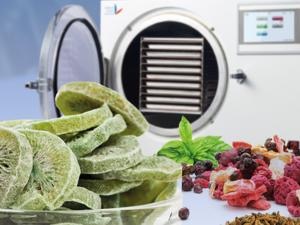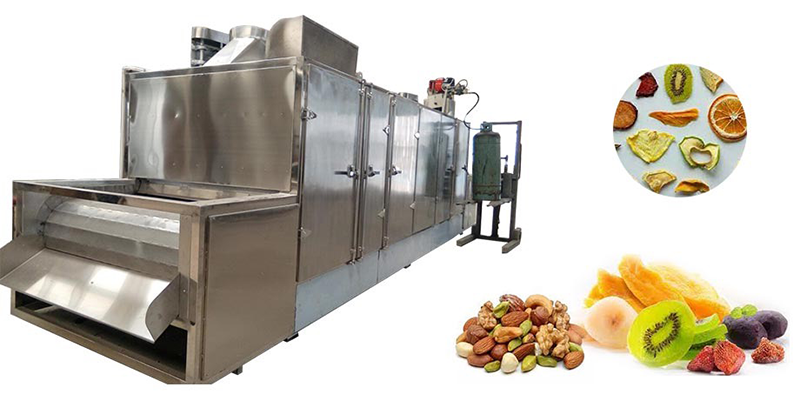
Content Menu
● Introduction to Food Drying Technology
● What is a Heat Pump Dryer?
● How Does a Heat Pump Dryer Work?
● Advantages of Heat Pump Dryers for Food Processing
>> Energy Efficiency
>> Gentle Drying Process
>> Versatility
>> No Ventilation Required
● Applications of Heat Pump Dryers in Food Industry
>> Fruit and Vegetable Drying
>> Herb Drying
>> Meat Drying
>> Snack Food Production
● Considerations for Using Heat Pump Dryers
>> Initial Investment
>> Maintenance Requirements
>> Learning Curve
● Environmental Impact of Heat Pump Dryers
>> Reduced Carbon Footprint
>> Water Conservation
● Future Trends in Food Drying Technology
>> Advancements in Heat Pump Technology
>> Growing Demand for Dried Foods
● Conclusion
● Frequently Asked Questions
>> 1. What types of food can be dried using a heat pump dryer?
>> 2. How does a heat pump dryer differ from a traditional dryer?
>> 3. Are heat pump dryers suitable for commercial use?
>> 4. What maintenance is required for heat pump dryers?
>> 5. Is the initial cost of a heat pump dryer worth it?
Introduction to Food Drying Technology
In the world of food preservation, drying is one of the oldest methods used to extend the shelf life of various food products. With advancements in technology, food drying has evolved significantly, leading to the development of modern food drying machines, including heat pump dryers. These machines are designed to efficiently remove moisture from food items while preserving their nutritional value, flavor, and texture.
Heat pump dryers are particularly popular in the food industry due to their energy efficiency and ability to operate without the need for external venting. This article will explore the workings of heat pump dryers, their advantages over traditional drying methods, and their applications in food processing.

What is a Heat Pump Dryer?
A heat pump dryer is a type of drying machine that uses a heat pump to transfer heat from the environment to the drying chamber. Unlike traditional dryers that expel hot air outside, heat pump dryers recycle the air within the system. This process not only conserves energy but also allows for precise temperature control, making it ideal for drying sensitive food products.
How Does a Heat Pump Dryer Work?
The operation of a heat pump dryer involves several key components:
1. Evaporator: This component absorbs heat from the surrounding air and converts it into vapor.
2. Compressor: The vapor is compressed, raising its temperature and pressure.
3. Condenser: The hot vapor is then passed through the condenser, where it releases heat to the drying chamber, warming the air inside.
4. Expansion Valve: After releasing heat, the vapor is allowed to expand, cooling it down before it returns to the evaporator.
This cycle continues, effectively removing moisture from the food while maintaining a controlled environment.
Advantages of Heat Pump Dryers for Food Processing
Energy Efficiency
One of the most significant advantages of heat pump dryers is their energy efficiency. They consume less energy compared to traditional dryers because they recycle heat rather than generating new heat. This feature is particularly beneficial for food manufacturers looking to reduce operational costs.
Gentle Drying Process
Heat pump dryers operate at lower temperatures, which helps preserve the quality of the food being dried. High temperatures can degrade sensitive nutrients and alter the flavor and texture of food products. The gentle drying process of heat pump dryers ensures that the food retains its original characteristics.
Versatility
Heat pump dryers can be used for a wide range of food products, including fruits, vegetables, herbs, and meats. Their ability to control temperature and humidity levels makes them suitable for drying various types of food without compromising quality.
No Ventilation Required
Unlike traditional dryers that require external venting, heat pump dryers can be installed in any location without the need for ductwork. This flexibility allows food manufacturers to optimize their production space and reduce installation costs.

Applications of Heat Pump Dryers in Food Industry
Fruit and Vegetable Drying
Heat pump dryers are widely used for drying fruits and vegetables. The controlled drying environment helps retain the color, flavor, and nutritional value of the produce. Dried fruits and vegetables are popular snacks and ingredients in various culinary applications. For instance, apples, bananas, and tomatoes can be dried to create healthy snacks or ingredients for soups and salads.
Herb Drying
Herbs are sensitive to heat, and traditional drying methods can lead to loss of essential oils and flavors. Heat pump dryers provide a gentle drying process that preserves the aromatic compounds in herbs, making them ideal for culinary and medicinal uses. Common herbs like basil, oregano, and thyme can be effectively dried using this technology, ensuring that their flavors remain intact for cooking and seasoning.
Meat Drying
In the production of dried meats, such as jerky, heat pump dryers offer precise temperature control to ensure safe and effective drying. The ability to maintain low temperatures helps prevent the growth of harmful bacteria while achieving the desired texture and flavor. This method is particularly useful for producing high-quality jerky that retains its taste and nutritional value.
Snack Food Production
The snack food industry benefits from heat pump dryers by producing high-quality dried snacks. From fruit chips to vegetable crisps, these dryers enable manufacturers to create healthy, shelf-stable products that appeal to health-conscious consumers. The versatility of heat pump dryers allows for the creation of innovative snack options, such as kale chips and sweet potato crisps, which are gaining popularity in the market.
Considerations for Using Heat Pump Dryers
Initial Investment
While heat pump dryers offer numerous benefits, the initial investment can be higher than traditional drying equipment. However, the long-term energy savings and improved product quality often justify the upfront costs. Many manufacturers find that the return on investment is realized through reduced energy bills and increased product sales due to higher quality.
Maintenance Requirements
Regular maintenance is essential to ensure the efficient operation of heat pump dryers. This includes cleaning filters, checking refrigerant levels, and inspecting components for wear and tear. Proper maintenance can extend the lifespan of the equipment and maintain its energy efficiency. Manufacturers should establish a routine maintenance schedule to prevent downtime and ensure optimal performance.
Learning Curve
For manufacturers transitioning from traditional drying methods to heat pump technology, there may be a learning curve involved. Understanding the operational parameters and optimizing drying cycles for different food products is crucial for achieving the best results. Training staff on the specific requirements of heat pump dryers can help streamline the transition and improve overall efficiency.
Environmental Impact of Heat Pump Dryers
Reduced Carbon Footprint
Heat pump dryers contribute to a lower carbon footprint compared to traditional dryers. By using less energy and reducing the need for external venting, these machines help minimize greenhouse gas emissions associated with food processing. As sustainability becomes increasingly important in the food industry, adopting energy-efficient technologies like heat pump dryers can enhance a company's environmental credentials.
Water Conservation
In addition to energy savings, heat pump dryers can also contribute to water conservation. Traditional drying methods often require significant amounts of water for cooling and cleaning processes. By utilizing a closed-loop system, heat pump dryers reduce water usage, making them a more sustainable option for food manufacturers.
Future Trends in Food Drying Technology
Advancements in Heat Pump Technology
As technology continues to evolve, we can expect further advancements in heat pump technology. Innovations may include improved energy efficiency, enhanced control systems, and integration with smart technology for better monitoring and management of drying processes. These advancements will likely lead to even greater adoption of heat pump dryers in the food industry.
Growing Demand for Dried Foods
The demand for dried foods is on the rise, driven by consumer preferences for healthy, convenient snacks. As more people seek out nutritious options, food manufacturers will need to invest in efficient drying technologies to meet this demand. Heat pump dryers are well-positioned to play a crucial role in this growing market.
Conclusion
Heat pump dryers represent a significant advancement in food drying technology. Their energy efficiency, gentle drying process, and versatility make them an excellent choice for food manufacturers looking to improve product quality while reducing operational costs. As the demand for high-quality dried foods continues to grow, heat pump dryers will play an increasingly important role in the food processing industry.

Frequently Asked Questions
1. What types of food can be dried using a heat pump dryer?
Heat pump dryers can be used to dry a variety of foods, including fruits, vegetables, herbs, and meats.
2. How does a heat pump dryer differ from a traditional dryer?
Unlike traditional dryers that vent hot air outside, heat pump dryers recycle air within the system, making them more energy-efficient and suitable for sensitive food products.
3. Are heat pump dryers suitable for commercial use?
Yes, heat pump dryers are widely used in commercial food processing due to their efficiency and ability to maintain product quality.
4. What maintenance is required for heat pump dryers?
Regular maintenance includes cleaning filters, checking refrigerant levels, and inspecting components to ensure optimal performance.
5. Is the initial cost of a heat pump dryer worth it?
While the initial investment may be higher, the long-term energy savings and improved product quality often make heat pump dryers a cost-effective choice.












